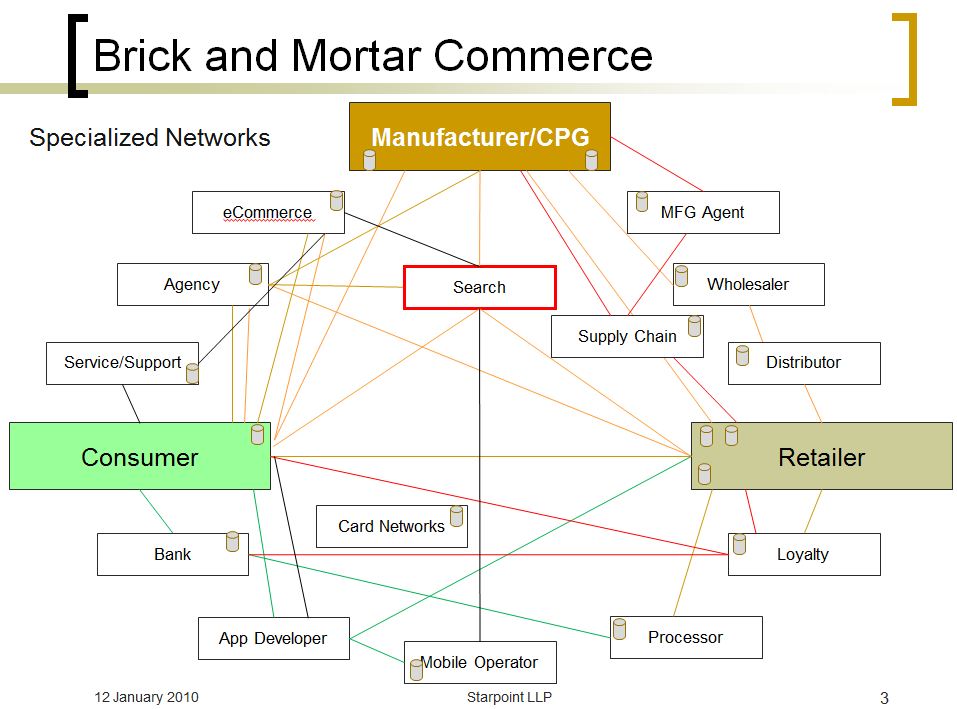10 Jan 2012
Historically I’ve been a big PayPal fan, and still am. I have a PayPal Debit card that I used this morning… and use PP every chance I get online. The online checkout process is just fantastic. In the good old days I earned more money from my PayPal money market then I did from my bank (savings and DDA), so my preference was always to keep a balance with them. Sadly this is no longer the case.
In my last post on PayPal (PayPal at the POS – Nov 18, 2011) I described PayPal’s challenges at the physical POS:
PayPal has no tools in its shed to deliver incremental value within a PHYSICAL commerce orchestration role.
There are few “payment problems” at the POS. For example, how often do you go to Home Depot and forget your wallet? Or go home empty handed because Home Depot wouldn’t accept your form of payment? Payment in and of itself is only the last phase of a long: product, marketing, retailing, pricing, selection, distribution and delivery buying process. Most retailers strongly believe that the cost of this last “payment” process has been disproportionately high relative to the value it brings. This is the key strategic battle being fought today in “mobile payments”. Banks and the card networks are trying their best to make “mobile payment” a premium service tied to 300bps+ cards… while retailers and manufactures are looking for solutions that will enable them to create new buying experiences. PayPal’s solution may bridge this transaction cost gap (blended rate), but does very little to address the physical buying process.
In the virtual world eBay is the lead orchestrator in this process (on its marketplace), as is Amazon. Key to Amazon’s and eBay’s ability to serve, as virtual world orchestrators, are their ability to control the buying process (end-end) AND the data. 
However in the physical world, the buying process is highly fragmented. The value that PayPal brings to Home Depot today is based upon their current product capabilities (payment + ?) and customer base (100M+ globally). If you were running store operations at Home Depot, what are you trying to accomplish with PayPal?
- Decrease transaction cost? Perhaps Home Depot has a high credit transaction mix and PayPal’s 200bps (my guess) cost is a net savings
- Increase basket size? Can Paypal incent customers to buy more
- Increase total annual sales? Get existing customers to buy more over the year
- Increase gross margin? Example set prices higher on shelf, as PayPal customers will get unique custom pricing
- Increase marketing effectiveness? Drive sales of targeted merchandise?
- Increase Loyalty? Decrease trips to competitors, increase share of wallet, …etc
I’m fortunate to have led teams at Oracle and 41st Parameter (a KP start up) that worked with some of the World’s largest Retailers (online and physical)….. It is based on this perspective that I see the following business issues with PayPal-Home Depot approach:
1. Incentive to use payment instrument. As a consumer why would I want to pay with my phone number? I know if I use my Amex card I get points.. what do I get here?
2. Home Depot value. What are the metrics around the pilot and what is success? I can’t imagine how this will drive sales or margin. eBay does not market, and if they did will consumers see the price for item on eBay? eBay is a competitor to most physical retailers.. a hyper efficient marketplace. eBay has few tools to market and influence a customer during the buying process.. I’m sure PayPal has develop some very cool instore tools.. but hey Home Depot could do that themselves.
3. Consumer protections. The reason I use a credit card at Home Depot are my Reg Z consumer protections. What happens if I have a dispute? Or want to return merchandise?
4. No need for PayPal. This is actually my number one reason.. Home Depot will eventually wake up and realize that they can keep the phone number based checkout.. but use it to ask the customer if they would like to pay with the same payment instrument they used last time. There is no need for PayPal anywhere in this process. This is what happens for me at my local grocery store today (Food Lion).
Make no mistake, I do like the idea of customers giving their phone number at the POS… but it is the retailers that should use this data to make an informed decision on payment instrument choice AND loyalty incentive (example Target’s decoupled debit 5% back, or Payfone/Verizon with VZ incentives).
As a side note, Patrick’s comments on my Galaxy Nexus blog led me to update my disclosure, and restate the obvious: my views are biased (no secret to my Obopay and Square friends). Today’s blog is consistent with what I have been telling eBay’s institutional investors.. there is plenty of runway for PayPal globally.. but physical POS is a distraction and they don’t have the physical retail team to tackle it. There are no payment problems at the POS.. per yesterday’s blog, the REAL opportunity is in rewiring commerce in ways which enable manufactures, consumers and retailers to interact. eBay’s virtual marketplace is a negative to most physical retailers.. as is Amazon’s. Retailers are looking for solutions which will increase sales and decrease transaction cost. A platform which begins with a new marketing paradigm (ex. Google) is much more likely to draw participation, particularly in a pay for performance model. If this hypothesis holds, what companies are best positioned to influence a customer before they buy?
Also see Googlization of Financial Services..
